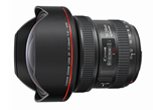

Press Release
Canon Celebrates Significant Milestone with Production of 110 Million Interchangeable EF Lenses
MELVILLE, N.Y., July 13, 2015 - Our parent company in Tokyo, Canon Inc., today announced the achievement of a new lens-manufacturing milestone with the production on June 22, 2015, of the Company’s 110-millionth EF-series interchangeable lens for EOS cameras—an EF11-24mm f/4L USM ultra-wide-angle interchangeable zoom lens.
 |
 |
|
110 Million EF lenses |
The 110-millionth EF-series lens produced: |
Production of interchangeable EF lenses for Canon EOS-series AF (autofocus) single-lens reflex film cameras began in 1987 at the Company’s Utsunomiya Plant. Over the years, EF lenses have gained support from a wide range of users and production has since expanded to a total of four manufacturing bases, including Canon Inc., Taiwan; Canon Opto (Malaysia) Sdn. Bhd.; and Oita Canon Inc. in southern Japan.
EF lens production surpassed the 10-million-unit mark in 1995 and crossed the 50-million-unit threshold in 2009. In April 2014, the Company celebrated its first-in-the-world achievement of having manufactured 100 million EF lenses, and now, setting a new world record for the most interchangeable lenses produced, Canon manufactured its 110-millionth EF lens in June 2015.
Canon’s proprietary EF lenses, launched in March 1987 along with the EOS SLR camera system, have continued to evolve since their introduction, leading the industry through the incorporation of a wide range of innovative technologies, including such world’s firsts as the Ultrasonic Motor (USM), Image Stabilizer (IS) technology, a multi-layered diffractive optical (DO) element, and Subwavelength Structure Coating (SWC) anti-reflection technology.
The 110-millionth EF lens, an EF11-24mm f/4L USM (launched in February 2015), boasts a minimum focal length of 11 mm to achieve the world’s widest angle of view.1 Furthermore, winner of the prestigious Camera Grand Prix Japan 2015 Lens of the Year award,2 the model was recognized for its generous use of Canon proprietary optical technologies, making possible superior image quality while effectively correcting for aberrations that commonly occur when shooting at the ultra-wide-angle end.
The Company’s extensive EF lens-series lineup currently comprises a total of 97 models,3 including EF Cinema Lenses for digital cinematography. Canon will continue refining its imaging technologies centered on its EF lens lineup, striving to cater to the varying needs of photographers—from first-time users to advanced amateurs and professionals—while contributing to expanding the photographic and video imaging culture.
1. Among lenses for interchangeable-lens cameras (SLR and compact system cameras). As of July 5, 2015, based on a Canon survey. Excludes fisheye lenses.
2. The Camera Grand Prix (GP) Japan awards, considered one of the most sought-after camera and lens product awards in Japan, are organized by the Camera Journal Press Club, comprising journalists from major photography and camera magazines in Japan.
3. Including two EF lens extenders and three models available outside of Japan. As of July 8, 2015.
Revolutionary Canon EF lenses over the years: main features and technologies
|
Model name |
Main features and technologies |
Launch date |
| EF300mm f/2.8L USM1 | World’s first2 use of a lens-based Ultrasonic Motor (USM) |
Nov. 1987 |
| USM technology delivers fast autofocusing thanks to its high torque and responsiveness. By converting ultrasonic vibrations into rotational energy, the technology makes possible quiet, smooth AF drive performance. | ||
| EF75-300mm f/4-5.6 IS USM3 | World’s first2 use of Image Stabilizer (IS) technology |
Sep. 1995 |
| Users can see the results of IS technology through the viewfinder. Delivering high precision and stability for exceptional image stabilization results, this technology expands the possibilities for handheld photography. | ||
| EF400mm f/4 DO IS USM4 | World’s first2 use of a diffractive optical (DO) lens element |
Dec. 2001 |
| Diffraction is an optical phenomenon in which light waves bend as they pass around the edges of an object. DO lens elements use this phenomenon to correct for a variety of aberrations by controlling the path that light travels. | ||
| EF24mm f/1.4L II USM | World’s first5 use of Subwavelength Structure Coating (SWC) |
Dec. 2008 |
| SWC technology minimizes reflections by aligning countless wedge-shaped structures more minute than the wavelength of visible light on the surface of a camera lens. | ||
| EF100mm f/2.8L Macro IS USM | World’s first2 use of Hybrid IS, which compensates for both angle camera shake and shift camera shake |
Oct. 2009 |
| Employing a newly developed algorithm, Hybrid IS optimally adjusts for camera shake based on information gathered by two sensors located in the lens. By precisely driving the optical correction system, the technology simultaneously corrects for angle and shift camera shake. | ||
| EF8-15mm f/4L Fisheye USM | World’s first2 fisheye lens to deliver both 180-degree diagonal angle of view and 180-degree circular fisheye |
Jul. 2011 |
| The EF8-15mm f/4L Fisheye USM enables the capture of images with dramatic deformations, exaggerated perspectives and extreme depths of field, making possible images that are significantly distorted, similar to what a fish might see were it to look skyward from under the water surface. | ||
| EF200-400mm f/4L IS USM Extender 1.4x | World’s first2 super-telephoto zoom lens to employ an internal extender |
May 2013 |
| Featuring a built-in 1.4x extender, the EF200-400mm f/4L IS USM Extender 1.4x’s zoom range can be expanded with a simple one-touch operation even in locations where users are unable to switch lenses. | ||
| EF11-24mm f/4L USM | World’s first2 lens offering ultra-wide-angle 11 mm minimum focal length |
Feb. 2015 |
| In addition to achieving the world’s widest angle of view starting at a minimum focal length of 11 mm, the EF11-24mm f/4L USM effectively corrects for aberrations commonly associated with ultra-wide-angle lenses, delivering superior image-quality performance. |
1. As of July 8, 2015, production for this lens has already been discontinued.
Successor: EF300mm f/2.8L IS II USM (launched in August 2011).
2. Among interchangeable SLR camera lenses.
3. As of July 8, 2015, production for this lens has already been discontinued.
Successor: EF70-300mm f/4-5.6 IS USM (launched in September 2005).
4. As of July 8, 2015, production for this lens has already been discontinued.
Successor: EF400 f/4 DO IS II USM (launched in November 2014).
5. Among photography lenses. About Canon U.S.A., Inc.:
Canon U.S.A., Inc., is a leading provider of consumer, business-to-business, and industrial digital imaging solutions to the United States and to Latin America and the Caribbean (excluding Mexico) markets. With approximately $31 billion in global revenue, its parent company, Canon Inc. (NYSE:CAJ), ranks third overall in U.S. patents granted in 2014† and is one of Fortune Magazine's World's Most Admired Companies in 2014. In 2014, Canon U.S.A. has received the PCMag.com Readers' Choice Award for Service and Reliability in the digital camera and printer categories for the 11th consecutive year. Canon U.S.A. is committed to the highest level of customer satisfaction and loyalty, providing 100 percent U.S.-based consumer service and support for all of the products it distributes. Canon U.S.A. is dedicated to its Kyosei philosophy of social and environmental responsibility. In 2014, the Canon Americas Headquarters secured LEED® Gold certification, a recognition for the design, construction, operations and maintenance of high-performance green buildings.
† Based on weekly patent counts issued by United States Patent and Trademark Office.
All referenced product names, and other marks, are trademarks of their respective owners.


 Press Releases
Press Releases

